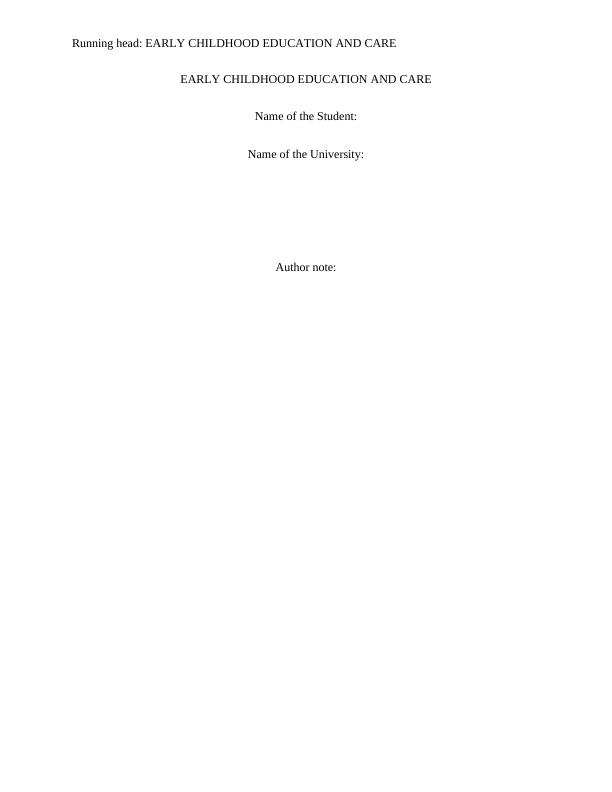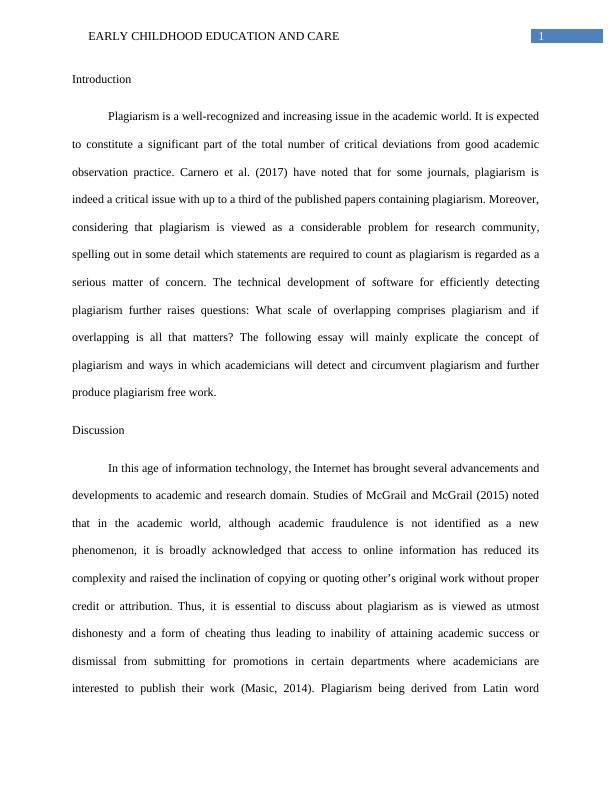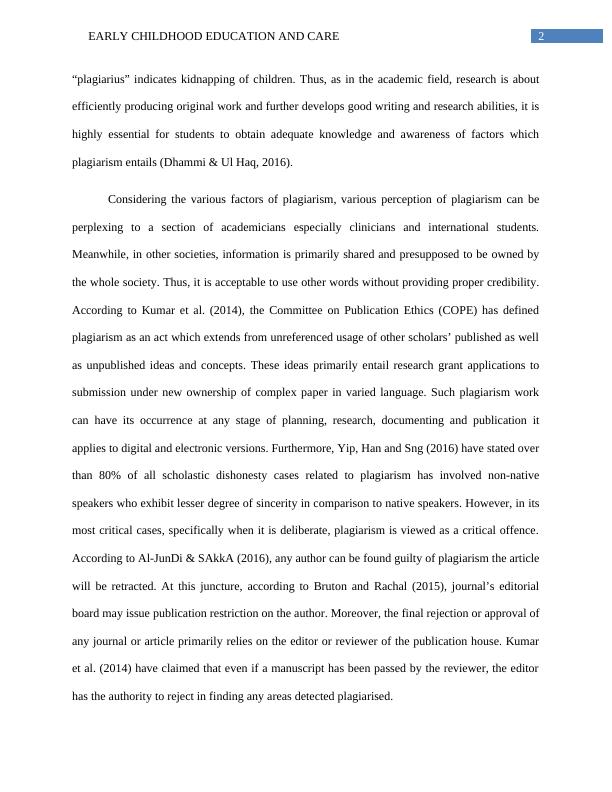Plagiarism in Academic Writing: Detection and Prevention
Added on 2023-04-25
9 Pages2288 Words377 Views
Running head: EARLY CHILDHOOD EDUCATION AND CARE
EARLY CHILDHOOD EDUCATION AND CARE
Name of the Student:
Name of the University:
Author note:
EARLY CHILDHOOD EDUCATION AND CARE
Name of the Student:
Name of the University:
Author note:

1EARLY CHILDHOOD EDUCATION AND CARE
Introduction
Plagiarism is a well-recognized and increasing issue in the academic world. It is expected
to constitute a significant part of the total number of critical deviations from good academic
observation practice. Carnero et al. (2017) have noted that for some journals, plagiarism is
indeed a critical issue with up to a third of the published papers containing plagiarism. Moreover,
considering that plagiarism is viewed as a considerable problem for research community,
spelling out in some detail which statements are required to count as plagiarism is regarded as a
serious matter of concern. The technical development of software for efficiently detecting
plagiarism further raises questions: What scale of overlapping comprises plagiarism and if
overlapping is all that matters? The following essay will mainly explicate the concept of
plagiarism and ways in which academicians will detect and circumvent plagiarism and further
produce plagiarism free work.
Discussion
In this age of information technology, the Internet has brought several advancements and
developments to academic and research domain. Studies of McGrail and McGrail (2015) noted
that in the academic world, although academic fraudulence is not identified as a new
phenomenon, it is broadly acknowledged that access to online information has reduced its
complexity and raised the inclination of copying or quoting other’s original work without proper
credit or attribution. Thus, it is essential to discuss about plagiarism as is viewed as utmost
dishonesty and a form of cheating thus leading to inability of attaining academic success or
dismissal from submitting for promotions in certain departments where academicians are
interested to publish their work (Masic, 2014). Plagiarism being derived from Latin word
Introduction
Plagiarism is a well-recognized and increasing issue in the academic world. It is expected
to constitute a significant part of the total number of critical deviations from good academic
observation practice. Carnero et al. (2017) have noted that for some journals, plagiarism is
indeed a critical issue with up to a third of the published papers containing plagiarism. Moreover,
considering that plagiarism is viewed as a considerable problem for research community,
spelling out in some detail which statements are required to count as plagiarism is regarded as a
serious matter of concern. The technical development of software for efficiently detecting
plagiarism further raises questions: What scale of overlapping comprises plagiarism and if
overlapping is all that matters? The following essay will mainly explicate the concept of
plagiarism and ways in which academicians will detect and circumvent plagiarism and further
produce plagiarism free work.
Discussion
In this age of information technology, the Internet has brought several advancements and
developments to academic and research domain. Studies of McGrail and McGrail (2015) noted
that in the academic world, although academic fraudulence is not identified as a new
phenomenon, it is broadly acknowledged that access to online information has reduced its
complexity and raised the inclination of copying or quoting other’s original work without proper
credit or attribution. Thus, it is essential to discuss about plagiarism as is viewed as utmost
dishonesty and a form of cheating thus leading to inability of attaining academic success or
dismissal from submitting for promotions in certain departments where academicians are
interested to publish their work (Masic, 2014). Plagiarism being derived from Latin word

2EARLY CHILDHOOD EDUCATION AND CARE
“plagiarius” indicates kidnapping of children. Thus, as in the academic field, research is about
efficiently producing original work and further develops good writing and research abilities, it is
highly essential for students to obtain adequate knowledge and awareness of factors which
plagiarism entails (Dhammi & Ul Haq, 2016).
Considering the various factors of plagiarism, various perception of plagiarism can be
perplexing to a section of academicians especially clinicians and international students.
Meanwhile, in other societies, information is primarily shared and presupposed to be owned by
the whole society. Thus, it is acceptable to use other words without providing proper credibility.
According to Kumar et al. (2014), the Committee on Publication Ethics (COPE) has defined
plagiarism as an act which extends from unreferenced usage of other scholars’ published as well
as unpublished ideas and concepts. These ideas primarily entail research grant applications to
submission under new ownership of complex paper in varied language. Such plagiarism work
can have its occurrence at any stage of planning, research, documenting and publication it
applies to digital and electronic versions. Furthermore, Yip, Han and Sng (2016) have stated over
than 80% of all scholastic dishonesty cases related to plagiarism has involved non-native
speakers who exhibit lesser degree of sincerity in comparison to native speakers. However, in its
most critical cases, specifically when it is deliberate, plagiarism is viewed as a critical offence.
According to Al-JunDi & SAkkA (2016), any author can be found guilty of plagiarism the article
will be retracted. At this juncture, according to Bruton and Rachal (2015), journal’s editorial
board may issue publication restriction on the author. Moreover, the final rejection or approval of
any journal or article primarily relies on the editor or reviewer of the publication house. Kumar
et al. (2014) have claimed that even if a manuscript has been passed by the reviewer, the editor
has the authority to reject in finding any areas detected plagiarised.
“plagiarius” indicates kidnapping of children. Thus, as in the academic field, research is about
efficiently producing original work and further develops good writing and research abilities, it is
highly essential for students to obtain adequate knowledge and awareness of factors which
plagiarism entails (Dhammi & Ul Haq, 2016).
Considering the various factors of plagiarism, various perception of plagiarism can be
perplexing to a section of academicians especially clinicians and international students.
Meanwhile, in other societies, information is primarily shared and presupposed to be owned by
the whole society. Thus, it is acceptable to use other words without providing proper credibility.
According to Kumar et al. (2014), the Committee on Publication Ethics (COPE) has defined
plagiarism as an act which extends from unreferenced usage of other scholars’ published as well
as unpublished ideas and concepts. These ideas primarily entail research grant applications to
submission under new ownership of complex paper in varied language. Such plagiarism work
can have its occurrence at any stage of planning, research, documenting and publication it
applies to digital and electronic versions. Furthermore, Yip, Han and Sng (2016) have stated over
than 80% of all scholastic dishonesty cases related to plagiarism has involved non-native
speakers who exhibit lesser degree of sincerity in comparison to native speakers. However, in its
most critical cases, specifically when it is deliberate, plagiarism is viewed as a critical offence.
According to Al-JunDi & SAkkA (2016), any author can be found guilty of plagiarism the article
will be retracted. At this juncture, according to Bruton and Rachal (2015), journal’s editorial
board may issue publication restriction on the author. Moreover, the final rejection or approval of
any journal or article primarily relies on the editor or reviewer of the publication house. Kumar
et al. (2014) have claimed that even if a manuscript has been passed by the reviewer, the editor
has the authority to reject in finding any areas detected plagiarised.

End of preview
Want to access all the pages? Upload your documents or become a member.
